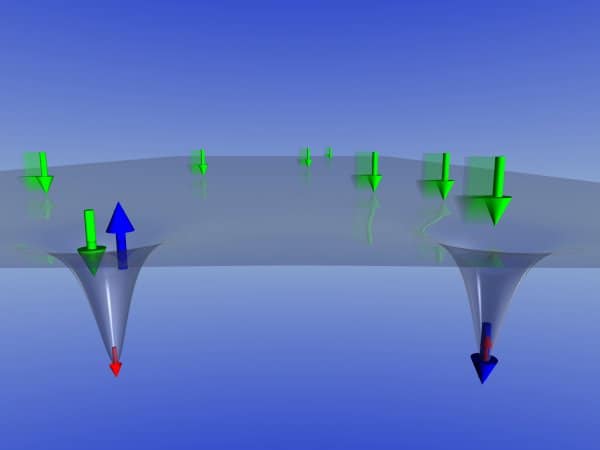
Physicists in the US and the UK have found a way to store and read data in nuclear spins using electronic pulses. The breakthrough could help in the development of spintronic systems that process information using spins – and could also find applications in quantum computation.
Spintronics is an emerging area of solid-state physics that attempts to use the spin as well as the charge of electrons to process data more efficiently. But a problem with electron spins is that they have a fairly short lifetime, which in practice would lead to corrupt data. For this reason scientists have been looking for new and better ways to store and retrieve information from spin systems.
One place to store spin-based information is in nitrogen-vacancy defects of a diamond crystal, and in recent years this has shown some promise. But the trouble with using diamond is that it is not compatible with conventional silicon-based electronics – a must if spintronic devices are ever to be integrated into computers.
Silicon-based breakthrough
Now, Dane McCamey of the University of Utah, Salt Lake City, and colleagues from Florida State University, Tallahassee, and University College London have found a way to store, and read, spins in a widely used semiconductor: phosphorous doped silicon (SiP). Their work marks the first time anyone has taken an electrical readout of data held in atomic nuclei.
Researchers have previously tried to map spin information (whether a spin is pointing up or down) onto nuclei and then read it, but had little success. The answer from McCamey’s group is to polarize all the conduction electrons in the SiP so that they are all in the same spin state. The do this by cooling the material to a few degrees above absolute zero and applying a strong magnetic field of some 8.5 T. They can then send in electromagnetic pulses near terahertz frequencies (1012 Hz) to write an up or down spin onto electrons orbiting the phosphorus atoms, before sending in radio waves to transfer those spins to the nuclei.
The team found the nuclei could store the spins for about 300,000 times longer than the typical electron spin lifetime. To read the spin information, the researchers simply did the reverse process: send in radio waves to transfer the spins from the nuclei back to the electrons, and then send in a final, near-terahertz pulse, which exhibited a greater current for an up-spin than a down-spin.
Must be flexible and easy to use
“Whether the scheme develops into further applications in spin quantum computation or spin electronics would depend a lot on whether this technique is flexible and relatively easy to use by the community,” said Sankar Das Sarma, a condensed-matter theorist at the University of Maryland. “It’s too soon to tell. What I can say is that I am quite impressed by the clever electrical read out technique used by the authors here, and I hope that this has a future in spintronics.”
According to John Morton, a materials scientist at Oxford University, the difficulty of developing the researchers’ scheme into applications might depend on what the application is. The low temperatures and high magnetic fields wouldn’t fare well with conventional computers, for which spintronics is destined. However, low temperatures might be less of a problem for quantum computers – that is, computers that exploit quantum physics to perform certain calculations much faster than computers in use today.
“Because a quantum computer is able to solve problems that a classical computer cannot in any reasonable amount of time, it doesn’t matter that you need to work at five Kelvin,” Morton said. “It doesn’t matter if you have a short lifetime and you need to keep running error-correcting algorithms – because you will be able to solve something that can’t be done elsewhere.”
McCamey told physicsworld.com that his group is now planning to scale down the number of nuclei used, so that they can isolate just a single nucleus to function as a memory element.
The research is published in Science 330 1652.



